The Norman-Byzantine style was a unique multicultural experiment that lasted several centuries. It was a singular movement which encompassed three diverse styles: Norman, Arab and Byzantine.
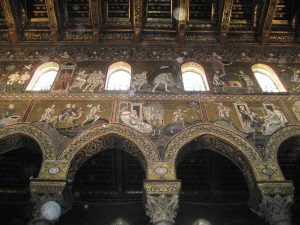
Image source: https://search.creativecommons.org/photos/29fc6337-a0dc-4227-b4e9-4c72ffc36647 by Stacy Spensley
History and Culture
The term Norman-Arab-Byzantine culture represents the combination of the Norman, Latin, Arab, and Byzantine Greek cultures. The fusion of cultures happened after the Norman conquest of Sicily and Norman Africa from 1061 to 1250. The Norman-Arab-Byzantine culture developed under the reign of Roger II of Sicily. He used Byzantine, Greek, and Arab troops in his campaigns in southern Italy. He also mobilized Arab and Byzantine architects to build monuments in the Norman-Arab-Byzantine style. Many Classical Greek works translated from Byzantine Greek manuscripts were found in Sicily directly into Latin. Under Norman rule, Sicily became a model widely admired throughout Europe and Arabia.
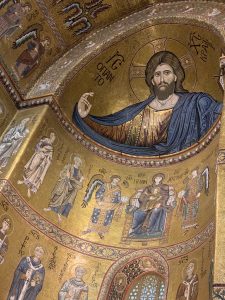
Image source: https://search.creativecommons.org/photos/2f163e85-6bcd-4c70-83ae-80064baffdd5 by jkrauss
Norman-Arab-Byzantine art
Norman-Arab-Byzantine art combined Occidental features with typical Islamic decorations, such as calligraphy and muqarnas. A lot of artistic techniques from the Islamic and Byzantine worlds are present in Arab-Norman art. For example, sculpture of ivory or porphyry, inlays in mosaics or metals, sculpture of stones, manufacture of silk, and bronze foundries. During a raid on the Byzantine Empire, admiral George of Antioch transported the silk weavers from Greece. The Byzantine silk industry was founded as part of the guarded monopoly. The new Norman rulers started to build different constructions, thus creating the Arab-Norman style. They incorporated the best practices of Byzantine and Arab architecture into the arts.
Byzantine Mosaics
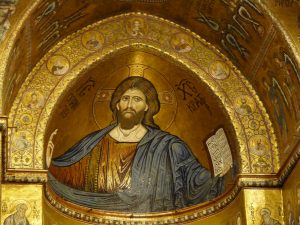
Image source: https://search.creativecommons.org/photos/fffb67d6-84c5-41ee-9e5b-f3181ba3562d by michael clarke stuff
Byzantine mosaics were produced from the 4th to 15th century under the heavy influence of the Byzantine Empire. Mosaics were the most popular and historically significant form of art in ancient empires. Byzantine mosaics evolved out of early Roman and Hellenic styles, made of small pieces of stone, glass, ceramic, or some material called tesserae. On the moist surface, artists drew images and used tools like compasses, strings, and calipers to outline geometric shapes. After that, the tesserae were cemented into position to create the final image. In addition, Byzantine mosaics went on to influence artists not only in the Norman Kingdom of Sicily but also in the Republics of Venice, Bulgaria, Romania, Serbia, and Russia.
Norman-Arab-Byzantine Architecture
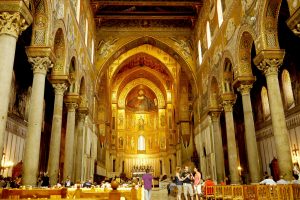
Image source: https://search.creativecommons.org/photos/eade64a8-6b2d-451d-b46d-37f084ffc013 by Madmartigand
The Cappella Palatina is a regal chapel located in the Palace of the Normans. It was first built as a palace for Arab emirs and their harems. During the reign of Roger II the Arabs abandoned the structure, yet by 1140 Roger II had built a new chapel. The Cappella Palatina combines harmoniously a variety of architectural styles. The gold-laden mosaics in the Cappella Palatina resemble the Byzantine style, while the chapel layout looks like a traditional Roman basilica. The arches in the Cappella Palatina belong to Saracen style, with other Arabic influences apparent with the 10th century. Clusters of four eight-pointed stars are typical for a Muslim design, even though they arranged to form a Christian cross.
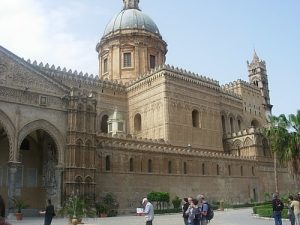
Image source: https://search.creativecommons.org/photos/cf43b9f8-775d-481f-a942-aa93291763a0 by Chiara Marra
Another example of Arab-Norman architecture is the “Palazzo dei Normanni” or “Castelbuono.” Formerly called al-Qasr, it was founded by the Emir of Palermo in the 9th century. Some parts of the original building are still visible in the basement. After the Normans conquered Sicily the palace was chosen as the main castle of the regnant.
Roger II in Palermo built the Church of Saint-John of the Hermits. This church is famous for its brilliant red domes, which showcase the Arab influence in Sicily.
Info source:
https://en.wikipedia.org/wiki/Norman-Arab-Byzantine_culture
http://www.seepalermo.com/byzantine.htm
http://interamericaninstitute.org/norman_sicily.htm
https://en.wikipedia.org/wiki/Byzantine_mosaics
https://enacademic.com/dic.nsf/enwiki/11829483
https://dreamofacity.com/2016/07/10/palermo-splendours-of-arab-norman-byzantine-culture/
